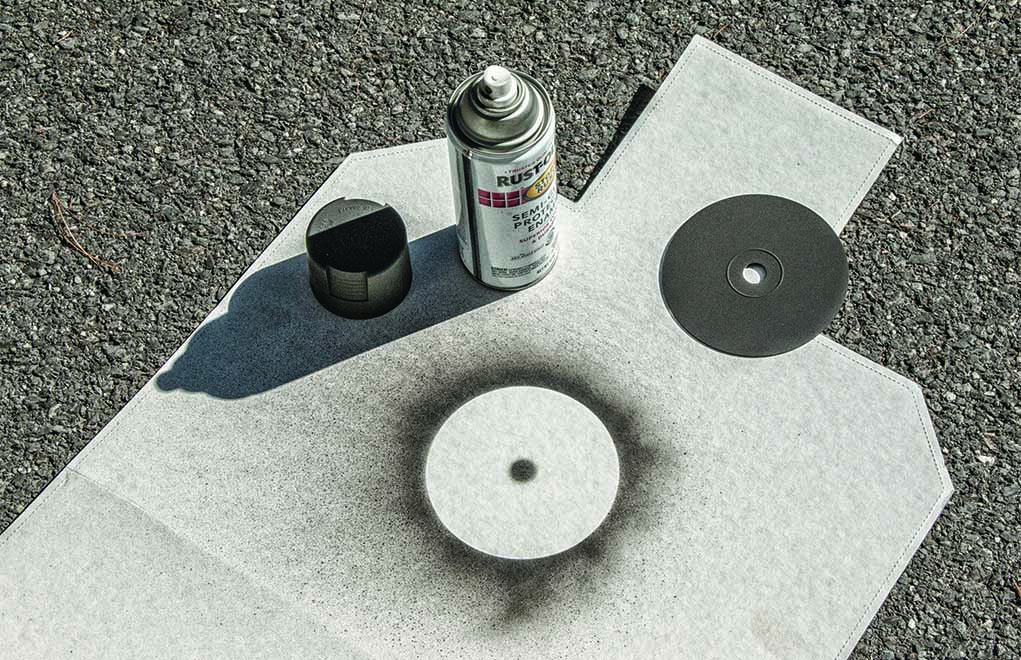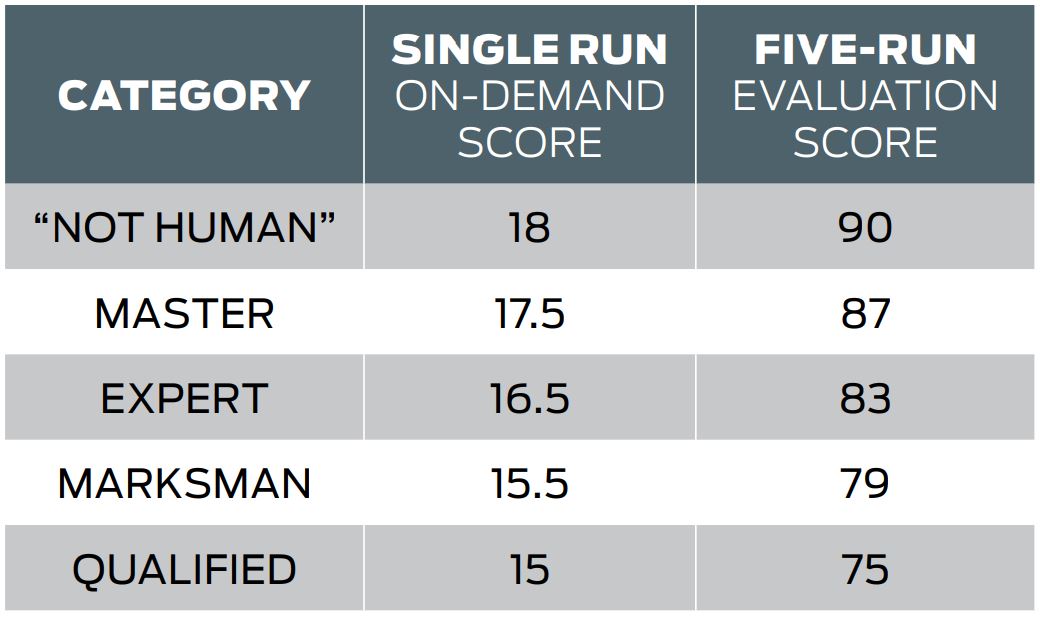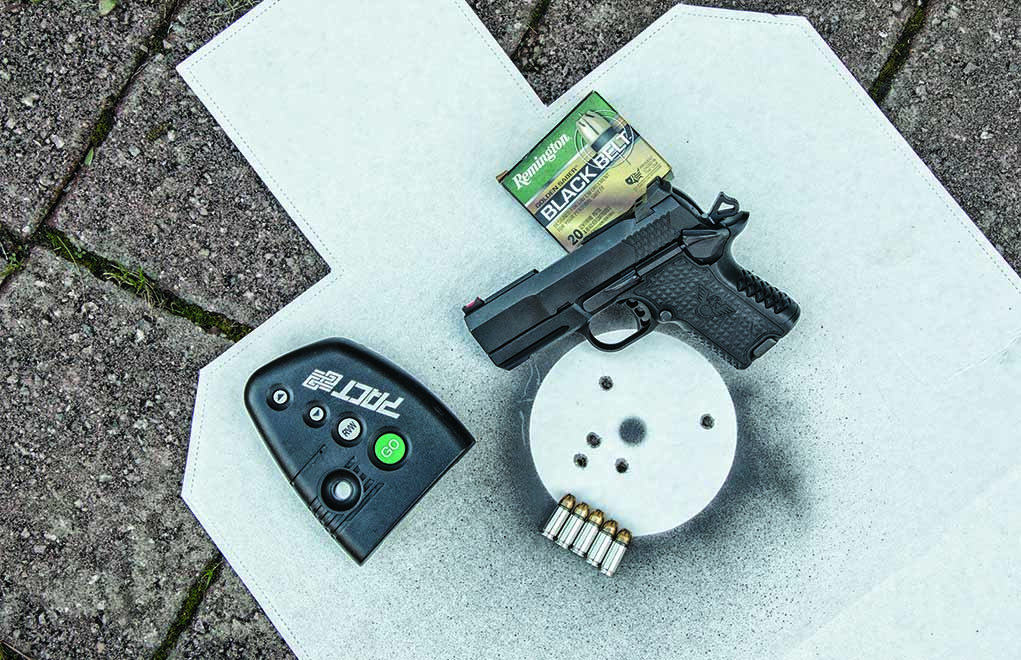
Do you know if your defensive handgun training is up to snuff? The Forty-Five Drill measures your likely
reaction if you’re actually attacked.
If you study actual shootings, you’ll soon see a trend. It’s very common for someone—a cop or civilian—to point their handgun at the bad guy and start pulling the trigger.
It seems that this dumping of available ammunition is not a conditioned response; it’s a reflexive one. From a handgun training standpoint, it’s easier to train to a reflexive response than it is to create a new, conditioned response. This is how the Forty-Five Drill came about. It’s an evaluation exercise that establishes your ability to do what you are, in fact, very likely to do if you’re actually attacked.
Testing Your Handgun Training
This drill involves drawing a handgun from concealment and engaging a 5-inch circle at a distance of 5 yards with five shots in fewer than five seconds. I gave it the “Forty-Five Drill” name because it’s made up of four elements of five: 5 yards, five shots, 5 inches and five seconds. Variations of this drill exist, but what they all have in common is the assessment of your ability to shoot a handful of shots into a relatively small area at close range at a fast pace.
I initially developed the Forty-Five Drill as a means for me to test and evaluate handguns, holsters and sights. By conducting the drill on a regular basis, it provides me with a good yardstick to measure my interface with various handguns, sights and other gear. Safeties that are hard to deactivate; sights that are hard to see; lasers that are difficult to activate; holsters that are hard to draw from; and cover garments that are unagreeable all stand out when subjected to this drill. Fundamentally, this exercise gives me a level playing field to learn what works for me and what doesn’t.
Get On Target With More Handgun Training:
On-Demand Performance
Based on my experiences teaching on the range and watching how civilians and police officers perform while others are teaching, I established that only about 5 percent of all police and civilian shooters are capable of performing this drill on demand. By “on demand,” I mean that you don’t get to warm up, practice or game it out. You step up to the line and, at the buzzer, you do your best while using your carry gun, carry ammo and wearing what you normally wear. Realism is key.

Drawing and shooting five shots from concealment is not the problem. The problem is putting all five bullets inside the 5-inch circle in fewer than five seconds. In fact, on average, you can expect 20 percent of the shooters to miss at least one shot, about 30 percent to miss two shots and about 30 percent to miss three or more shots when attempting this drill. The other 15 percent will get their hits—but not within the five-second time limit.
I’ve conducted this drill so many times that I figured it was about time I established a scoring process to help me better compare guns, gun features, gear and my performance. I kept the scoring just as simple as the drill.
Each hit is worth four points, so in a string of five shots, there are 20 points possible. You take the total points and subtract the time. A perfect score of 20 is unobtainable, because it would require you to get all five hits in zero seconds. While the “on-demand” single run is a good handgun training benchmark, it’s of little value when making comparisons. So, ideally, you run the drill five times, total the points and then subtract the total time.
As it should be, a score of 100 is also impossible. So, I’ve broken down the scoring to reflect various levels of competency:
What’s more important than the scores or any competency level they reflect is how you use them. I’d suggest starting off each handgun training session with an on-demand run of the Forty-Five Drill. Keep a record of your performance and compare it to previous and future runs that you start your training session with.
The five-run evaluation drill is good to conduct at the end of a training session. You can use it to establish a baseline of performance, as well as a means to compare how well you did with a new holster, sight or even a new handgun.
Journal your scores and even keep notes about issues you encounter while conducting the drill; that is, notes about things such as:
- The safety was hard to disengage
- The laser was hard to activate
- The cover garment or holster slowed your draw
- The gun just did not feel good in your hand
You might find that your favorite gun doesn’t perform as well on this drill as one you like a bit less. I ran this drill with my laser-sighted .45 ACP Nighthawk Commander, my Lightweight Browning Hi-Power and a prototype of the new X9S from Wilson Combat. I scored 78.24 with the Nighthawk, 83.59 with the Hi-Power and 79.13 with the X9S.
Reflexive Response
The beauty of this drill’s simplicity and its uncomplicated scoring system is that it allows you to easily compare the real-world performance of various guns and gear. More importantly, it evaluates your ability to do something you just might have to actually do one day: draw from concealment and get multiple hits on a single lethal threat—in a hurry. Because this drill reduces the use of a defensive handgun to its most basic application, it could also be called the “Gunfighter Drill.” In essence, that’s exactly what this drill is examining—your ability to reflexively respond with a defensive handgun to a fight your life will depend on.
To conduct the Forty-Five/Gunfighter Drill, you’ll need a shot timer and a torso-type target with a 5-inch circle. The best resources I’ve found for this drill are a PACT Club Shot Timer, an MGM Target Stand and a cardboard IPSC target. The easiest way to make the 5-inch circle is to lay an old CD/DVD on the target in the high chest area and spray around it with dark-colored paint.

The article originally appeared in the January 2020 issue of Gun Digest the Magazine.
 NEXT STEP: Download Your Free Storm Tactical Printable Target Pack
NEXT STEP: Download Your Free Storm Tactical Printable Target Pack
62 Printable MOA Targets with DOT Drills – Rifle Range in YARDS This impressive target pack from our friends at Storm Tactical contains 62 printable targets for rifle and handgun range use. Target grids and bullseye sizes are in MOA. Ideal for long-range shooting! Get Free Targets

